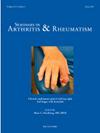Serological clusters in systemic lupus erythematosus and its clinical and prognostic implications: A longitudinal cohort study
IF 4.4
2区 医学
Q1 RHEUMATOLOGY
引用次数: 0
Abstract
Introduction
Systemic lupus erythematosus (SLE) is a heterogeneous autoimmune disorder characterized by multi-organ involvement and variable clinical manifestations. Recurrent clinical patterns suggest distinct phenotypes, where cluster analysis of autoantibodies could identify prognostic subtypes.
Objectives
To define and describe serological clusters and their clinical-epidemiological characteristics, as well as their association with comorbidities, disease activity measures, severity, and damage.
Materials and methods
Descriptive, observational, and multicenter study including SLE patients from the Spanish Registry RELESSER. Gower distance was used for cluster analysis.
Results
A total of 1,740 patients from the cross-sectional phase and 718 from the prospective phase with a four-year follow-up were included. Four serological clusters were identified. Cluster 1 (negative for extractable nuclear antigen [ENA]) was characterized by a lower frequency of vasculitis, leukopenia, and lymphopenia. Cluster 2 (positive antiphospholipid antibodies) more frequently presented haemolytic anaemia, thrombocytopenia, vasculitis and visual alterations and required greater use of immunoglobulins and oral anticoagulants. Cluster 3 (positive anti-SSA/Ro and anti-SSB/La) had a lower incidence of lupus nephritis. Cluster 4 (positive anti-Sm and anti-ribonucleoproteins) was characterized by higher rates of lupus nephritis, leukopenia, lymphopenia, hypocomplementemia, myositis and cutaneous manifestations and greater use of glucocorticoids and immunosuppressants. Patients in cluster 2 had higher baseline damage scores measured by the SLICC/ACR DI (Systemic Lupus International Collaborating Clinics/American College of Rheumatology Damage Index), while patients in cluster 4 had higher severity scores measured by the Katz Index. These differences among clusters persisted over the four-year of follow-up.
Conclusion
In our SLE patient population, the serological profile is key not only for clinical stratification but also for prognostic value.

系统性红斑狼疮的血清学聚集及其临床和预后意义:一项纵向队列研究
系统性红斑狼疮(SLE)是一种多器官受累和临床表现多变的异质自身免疫性疾病。复发的临床模式提示不同的表型,其中自身抗体的聚类分析可以确定预后亚型。目的定义和描述血清学聚集性及其临床流行病学特征,以及它们与合并症、疾病活动度、严重程度和损害的关系。材料和方法描述性、观察性和多中心研究,包括来自西班牙注册中心的SLE患者。聚类分析采用高尔距离法。结果共纳入了1,740例横断面期患者和718例前瞻性期患者,随访4年。鉴定出4个血清学聚类。第1组(可提取核抗原[ENA]阴性)的特点是血管炎、白细胞减少和淋巴细胞减少的发生率较低。第2组(抗磷脂抗体阳性)更常出现溶血性贫血、血小板减少、血管炎和视力改变,需要更多地使用免疫球蛋白和口服抗凝剂。第3组(抗ssa /Ro和抗ssb /La阳性)狼疮性肾炎的发生率较低。第4组(抗sm和抗核糖核蛋白阳性)的特点是狼疮肾炎、白细胞减少、淋巴细胞减少、低补体血症、肌炎和皮肤症状的发生率较高,糖皮质激素和免疫抑制剂的使用较多。通过SLICC/ACR DI(系统性狼疮国际合作诊所/美国风湿病学会损伤指数)测量,第2组患者的基线损伤评分较高,而第4组患者的严重程度评分较高。这些组间的差异在四年的随访中持续存在。结论:在我们的SLE患者群体中,血清学特征不仅是临床分层的关键,也是预后价值的关键。
本文章由计算机程序翻译,如有差异,请以英文原文为准。
求助全文
约1分钟内获得全文
求助全文
来源期刊
CiteScore
9.20
自引率
4.00%
发文量
176
审稿时长
46 days
期刊介绍:
Seminars in Arthritis and Rheumatism provides access to the highest-quality clinical, therapeutic and translational research about arthritis, rheumatology and musculoskeletal disorders that affect the joints and connective tissue. Each bimonthly issue includes articles giving you the latest diagnostic criteria, consensus statements, systematic reviews and meta-analyses as well as clinical and translational research studies. Read this journal for the latest groundbreaking research and to gain insights from scientists and clinicians on the management and treatment of musculoskeletal and autoimmune rheumatologic diseases. The journal is of interest to rheumatologists, orthopedic surgeons, internal medicine physicians, immunologists and specialists in bone and mineral metabolism.

 求助内容:
求助内容: 应助结果提醒方式:
应助结果提醒方式:


